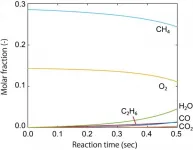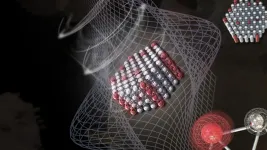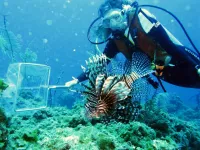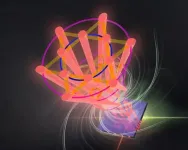Terahertz waves from electrons oscillating in liquid water
2021-03-04
(Press-News.org) Ionization of water molecules by light generates free electrons in liquid water. After generation, the so-called solvated electron is formed, a localized electron surrounded by a shell of water molecules. In the ultrafast localization process, the electron and its water shell display strong oscillations, giving rise to terahertz emission for tens of picoseconds.
Ionization of atoms and molecules by light is a basic physical process generating a negatively charged free electron and a positively charged parent ion. If one ionizes liquid water, the free electron undergoes a sequence of ultrafast processes by which it loses energy and eventually localizes at a new site in the liquid, surrounded by a water shell [Fig. 1]. The localization process includes a reorientation of water molecules at the new site, a so-called solvation process, in order to minimize the electric interaction energy between the electron and the water dipole moments. The localized electron obeys the laws of quantum mechanics and displays discrete energy levels. Electron localization occurs in the subpicosecond time range (1 ps = 10^-12 s = a millionth of a millionth of a second) and is followed by dissipation of excess energy into the liquid.
Researchers at the Max-Born-Institute have now observed radiation in the terahertz range (1 THz = 10^12 Hz = 10^12 oscillations per second) which is initiated during the electron localization process. As they report in the recent issue of Physical Review Letters, Vol. 126, 097401 (2021), the THz emission can persist for up to 40 ps, i.e., much longer than the localization process itself. It displays a frequency between 0.2 and 1.5 THz, depending on the electron concentration in the liquid.
The emitted THz waves originate from oscillations of the solvated electrons and their water shells. The oscillation frequency is determined by the local electric field the liquid environment exerts on this quantum system. Adding hydrated electrons to the liquid changes the local field and, thus, induces a change of oscillation frequency with electron concentration. Most surprising is the comparably weak damping of the oscillations which points to a weak interaction with the fluctuating larger environment in the liquid and a longitudinal character of the underlying electron and water motions.
The new experimental results are accounted for by a theoretical model based on a polaron picture as explained in Fig. 1. The polaron is an excitation which includes coupled motions of the electron and the water shell at low frequency. Due to such internal oscillations of charge, the hydrated electron radiates a THz wave. The weak damping of this wave allows for a manipulation of the emission, e.g., by interaction of the hydrated electron with a sequence of ultrashort light pulses.
INFORMATION:
[Attachments] See images for this press release:
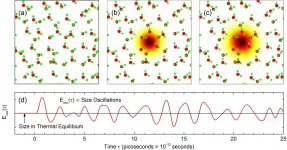
ELSE PRESS RELEASES FROM THIS DATE:
2021-03-04
CHAPEL HILL, North Carolina--UNC Lineberger Comprehensive Cancer Center researchers have successfully used an experimental safety switch, incorporated as part of a chimeric antigen receptor T-cell (CAR-T) therapy, a type of immunotherapy, to reduce the severity of treatment side effects that sometimes occur. This advance was seen in a patient enrolled in a clinical trial using CAR-T to treat refractory acute B-cell leukemia. It demonstrates a proof-of-principle for possible expanded use of CAR-T immunotherapy paired with the safety switch.
The researchers published their findings in the journal Blood as an ahead-of-print publication.
With CAR-T therapy, T-cells from a patient's immune system ...
2021-03-04
The human genome contains roughly three million letters. On average, the genome sequences of any two people differ from each other by about one in every 1,000 letters. Yet different variants occur, from substituted letters to entire missing sections of DNA. Scientists from the Berlin Institute of Health (BIH) and the Regensburg Center for Interventional Immunology (RCI) have teamed up with Icelandic researchers to develop software that reliably and quickly identifies large deletions in ten-thousands of genomes simultaneously. The researchers have now published their findings in the journal Nature Communications.
The human genome contains roughly three million letters ...
2021-03-04
Japanese researchers have developed a simulation method to theoretically estimate the performance of heterogeneous catalyst by combining first-principles calculation (1) and kinetic calculation techniques. Up to now, simulation studies mainly focused on a single or limited number of reaction pathways, and it was difficult to estimate the efficiency of a catalytic reaction without experimental information.
Atsushi Ishikawa, Senior Researcher, Center for Green Research on Energy and Environmental Materials, National Institute for Materials Science (NIMS), performed computation of reaction kinetic information from first-principles calculations based on quantum mechanics, and developed methods and programs to carry out kinetic simulations ...
2021-03-04
The speed at which we produce facial expressions plays an important role in our ability to recognise emotions in others, according to new research at the University of Birmingham.
A team in the University's School of Psychology carried out research which showed that people tend to produce happy and angry expressions more rapidly, while sad expressions are produced more slowly.
The team found that our ability to form judgements about people's facial expressions has close links with the speeds at which those expressions are produced and is also closely related to the ways in which we would produce those expressions ourselves. The study is published in Emotion.
"Being able to recognise and interpret ...
2021-03-04
Much like the Jedis in Star Wars use 'the force' to control objects from a distance, scientists can use light or 'optical force' to move very small particles.
The inventors of this ground-breaking laser technology, known as 'optical tweezers', were awarded the 2018 Nobel Prize in physics.
Optical tweezers are used in biology, medicine and materials science to assemble and manipulate nanoparticles such as gold atoms. However, the technology relies on a difference in the refractive properties of the trapped particle and the surrounding environment.
Now scientists have discovered a new technique that allows them to manipulate particles that have the same refractive ...
2021-03-04
The vegan diet is on trend. How this type of diet affects health is the subject of scientific studies. In a new study from the German Federal Institute for Risk Assessment (BfR), the bone health of 36 vegans as well as 36 people following a mixed-food diet was determined with an ultrasound measurement of the heel bone. The result: on average, people following a vegan diet had lower ultrasound values compared to the other group. This indicates poorer bone health.
In the study, the scientists also determined biomarkers in blood and urine. This aims ...
2021-03-04
Managing invasive species--not eliminating them altogether--is a better use of time and conservation resources in many cases, according to a study led by a University of Alberta biologist.
Every year, hundreds of introduced species cause billions of dollars in damage to ecosystems, agriculture and infrastructure in North America alone. The research, led by Stephanie Green, makes a case for working smarter, not harder, to temper the impact of destructive and widespread invasive species using a strategy called functional eradication.
"Rather than trying to completely eliminate invasive species that have spread over large areas, which is very ...
2021-03-04
Typically, light emitted from standard lasers has a controllable degree of freedom (DoF) which may be polarisation or beam shape. By suitably manipulating a laser with the introduction of specialised optical components, an output with 2 DoFs, such as vector vortex beams with controllable polarisation and orbital angular momentum (OAM). The term 'vector' describes a structured change in the polarisation across the beam and 'vortex' describes the twisting of the phase in the beam (OAM), much like a twisting tornado. Transcending 2 DoFs from a laser was not possible. By exploiting ray-wave duality in a frequency-degenerate laser, ...
2021-03-04
Being older, overweight and having low haemoglobin levels (fewer red blood cells) could increase a patient's risk of developing debilitating nerve damage following chemotherapy, a research team led by UNSW Sydney has revealed.
The researchers aimed to identify pre-treatment clinical and blood-based risk factors in patients who developed chemotherapy-induced peripheral neuropathy (CIPN) - nerve damage in peripheral body parts, like hands or feet, as a result of chemotherapy.
The study, published in JAMA Network Open recently, examined patients - mostly women - who received paclitaxel or oxaliplatin chemotherapy treatment, which are common treatments for breast, colorectal and gynaecological ...
2021-03-04
In a colourful solution to a dangerous problem, Australian scientists are adapting a component from cutting-edge solar cells to design a rapid, light-based detection system for deadly toxins.
While use of chemical warfare agents like sulfur mustard - better known as mustard gas - is banned internationally, we do rely on other strictly-controlled chemicals for agriculture, industry and throughout our daily lives, including fumigants like methyl iodide, which is used to control insects and fungi. The wrong amounts or incorrect use of these fumigants can be harmful to people and degrade the ozone layer.
Because it's invisible and doesn't smell, it's hard to tell whether there are dangerous amounts of methyl iodide present, and until ...
LAST 30 PRESS RELEASES:
[Press-News.org] Terahertz waves from electrons oscillating in liquid water


